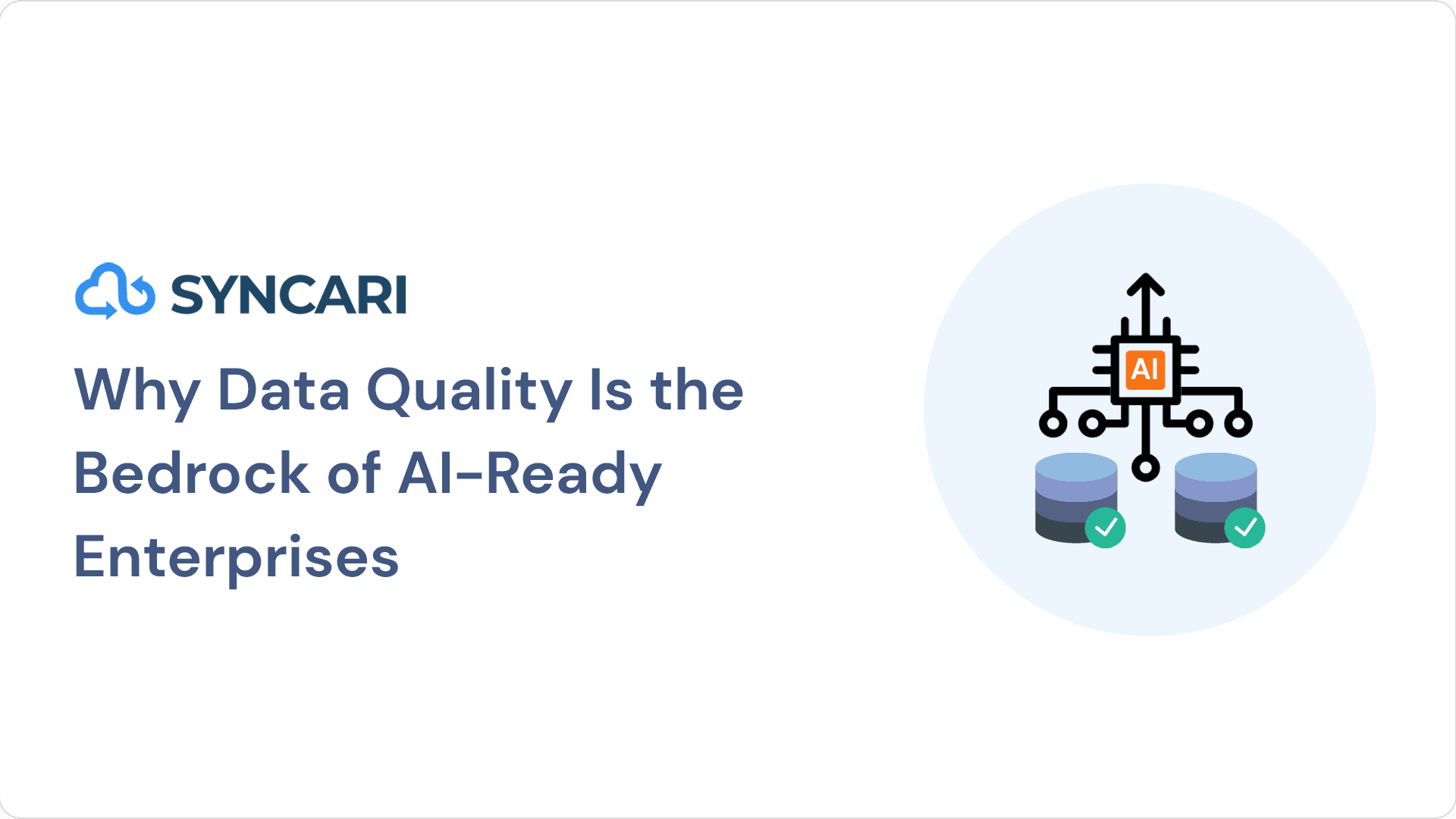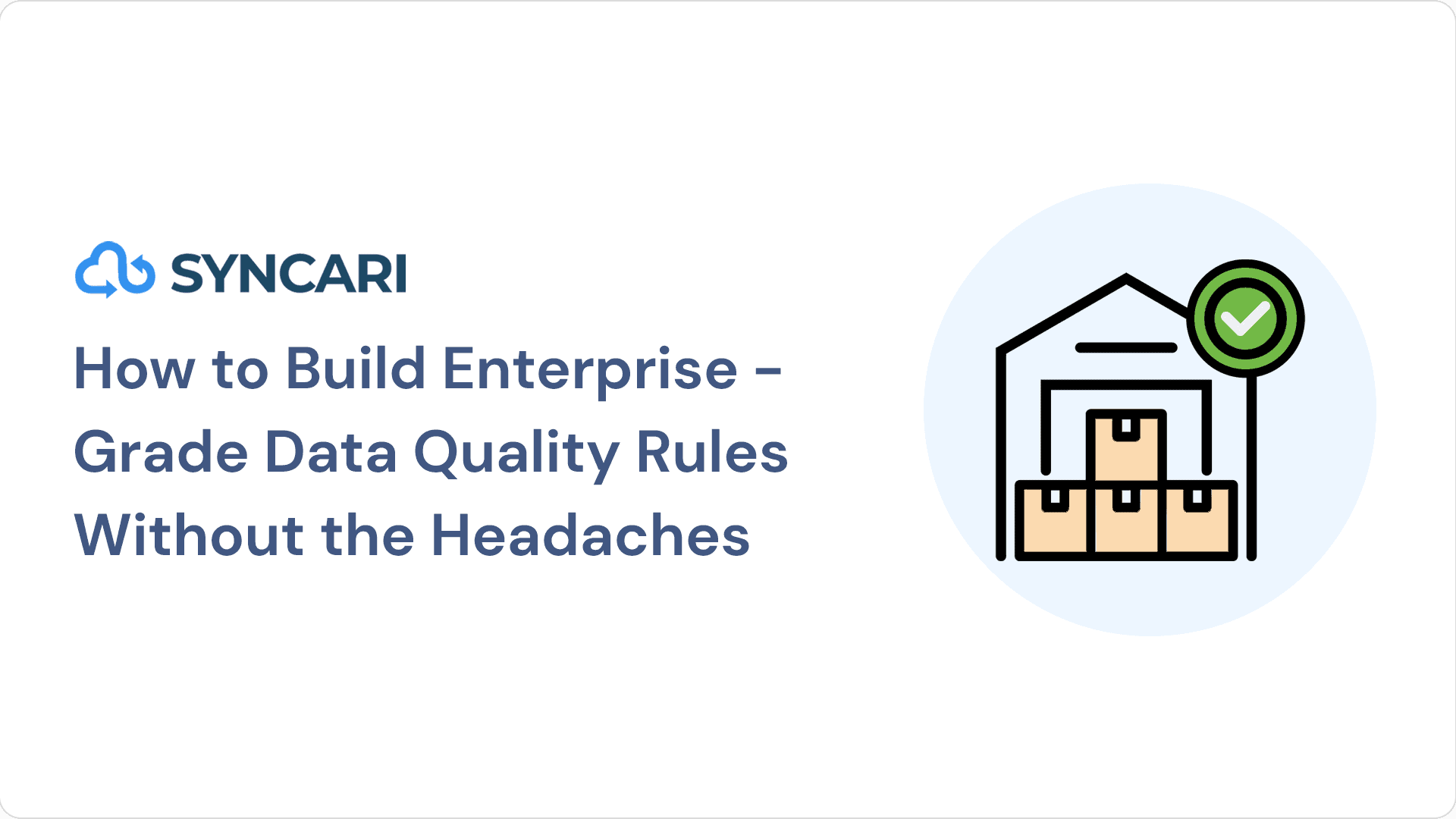Data quality is a critical factor in today’s data-driven business landscape. However, ensuring data quality manually is challenging due to increasing data volume and complexity. That’s where data quality automation comes in. In this blog post, we’ll explore the concept of data quality automation, its importance in business operations and revenue operations (such as data quality in CRM), the challenges of manual data quality efforts, and how automation addresses these challenges effectively.
Data quality automation refers to using technology and tools to automate data cleansing, validation, and enrichment. It ensures accurate, complete, and consistent data throughout systems and processes.
High-quality data is essential for informed decision-making, operational efficiency, and compliance, but manual data quality efforts are time-consuming, error-prone, and expensive. Disparate data sources and complex transformations make it difficult to maintain data quality consistently.
Data quality automation solves these challenges via leveraging automation technologies and intelligent algorithms. It streamlines data processes, eliminates errors, and enforces governance policies and ultimately empowers organizations to unlock the value of their data assets.
Read on as we’ll explore the benefits of data quality automation, best practices for implementation, challenges faced, and future trends. By the end, you’ll have a clear understanding of data quality automation and actionable insights for implementation to start your journey.
What is Data Quality Automation?
Data quality automation refers to the process of using automated systems, tools, and techniques to ensure that the data in an organization’s systems is accurate, complete, consistent, and up-to-date. This is a crucial aspect of data management and is particularly relevant in the context of big data applications, where manual checking of data quality is often not feasible due to the volume of data involved.
Data quality automation can include a variety of specific tasks, such as:
- Data Cleansing: The process of detecting and correcting (or removing) corrupt, inaccurate, or irrelevant records from a dataset or database.
- Data Validation: Ensuring that the data collected or used is accurate, meaningful, and relevant to the context. This might involve checking for logical consistency, correctness of format, etc.
- Data Profiling: The process of examining the data available in an existing database and collecting statistics or informative summaries about this data.
- Data Deduplication: The process of eliminating redundant copies of data.
- Data Standardization: Making sure data adheres to specific formatting rules or standards for consistency.
- Data Enrichment: Adding value to raw data by linking it with additional information from external sources.
- Benefits of Data Quality Automation
Data quality automation offers numerous advantages that positively impact various aspects of business operations. Let’s delve into some of the key benefits it provides.
Improved Accuracy and Reliability of Data:
Data quality automation employs advanced algorithms and techniques to cleanse, validate, and enrich data automatically. By eliminating manual errors and inconsistencies, it ensures the accuracy and reliability of data across systems and processes. This, in turn, enhances trust in the data and promotes confident decision-making.
Enhanced Decision-Making and Business Intelligence
High-quality data is the foundation of sound decision-making and effective business intelligence. Data quality automation ensures that the data used for analysis, reporting, and strategic planning is clean, consistent, and up-to-date. This enables organizations to derive meaningful insights, identify trends, and make informed decisions that drive business growth and innovation.
Increased Operational Efficiency and Cost Savings
Manual data quality efforts are time-consuming and resource-intensive. Data quality automation significantly improves operational efficiency by automating data cleansing, standardization, and validation processes. It reduces the need for manual intervention, saves time, and frees up resources for more value-added activities. Moreover, automation reduces the costs associated with manual errors, rework, and compliance violations, resulting in substantial cost savings for organizations.
Mitigation of Risks Associated with Poor Data Quality
Poor data quality can lead to various risks, such as erroneous insights, compliance issues, customer dissatisfaction, and reputational damage. Data quality automation mitigates these risks by proactively identifying and resolving data inconsistencies, duplicates, and inaccuracies. It ensures that data adheres to defined quality standards, regulatory requirements, and industry best practices. By maintaining high data quality, organizations can avoid costly errors, compliance penalties, and potential business disruptions.
Data quality automation offers a range of benefits for organizations. It improves the accuracy and reliability of data, enables better decision-making and business intelligence, enhances operational efficiency, and mitigates risks associated with poor data quality. By embracing data quality automation, businesses can unlock the full potential of their data assets and gain a competitive edge in today’s data-driven landscape.
Best Practices for Implementing Data Quality Automation
Implementing data quality automation requires careful planning and execution. By following best practices, organizations can optimize the effectiveness and efficiency of their data quality initiatives. Here are key practices to consider:
Define Clear Data Quality Goals and Metrics
Start by establishing specific data quality goals aligned with business objectives. Define metrics to measure data quality, such as accuracy, completeness, consistency, and timeliness. Clear goals and metrics provide a benchmark for evaluating the success of data quality automation efforts.
Assess and Clean Existing Data
Before implementing data quality automation, assess the quality of existing data. Identify data inconsistencies, duplicates, and inaccuracies. Cleanse and standardize the data to ensure a solid foundation for automation. This step may involve data profiling, data deduplication, and data cleansing techniques.
Establish Data Governance Policies and Processes
Data governance plays a crucial role in maintaining data quality. Establish data governance policies and processes that define roles, responsibilities, and accountability for data quality. Ensure compliance with regulations, define data standards, and establish data stewardship practices. A well-defined data governance framework supports effective data quality automation.
Select Appropriate Data Quality Automation Tools:
Choose data quality automation tools that align with your organization’s specific needs and requirements. Evaluate tools based on their capabilities for data profiling, data cleansing, data validation, and data enrichment. Consider factors such as scalability, ease of integration, user-friendliness, and vendor support. Select tools that offer flexibility and can adapt to your evolving data landscape.
Integrate Data Quality into Existing Workflows
Data quality automation should seamlessly integrate into existing data workflows and processes. Identify touchpoints where data quality checks and interventions are necessary. Embed data quality automation within these workflows to ensure consistent and real-time data validation and enrichment. Integration minimizes disruption and maximizes the impact of automation efforts.
Implement Ongoing Monitoring and Maintenance
Data quality is not a one-time effort. Implement regular monitoring and maintenance processes to sustain high data quality over time. Set up automated monitoring mechanisms to identify data quality issues proactively. Implement data quality audits and periodic data profiling to detect anomalies. Continuously refine and optimize data quality automation processes to adapt to evolving data requirements.
By following these best practices, organizations can lay a strong foundation for successful data quality automation initiatives. Clear goals, thorough data assessment, robust data governance, appropriate tool selection, seamless integration, and ongoing monitoring are key to achieving and maintaining high-quality data.
Choosing the Right Data Quality Automation Solution
Selecting the right data quality automation solution is crucial for the success of your data quality initiatives. To make an informed decision, consider the following key factors:
Assessing Organization’s Specific Needs and Requirements
Begin by understanding your organization’s specific needs and requirements. Assess the scale and complexity of your data landscape, data sources, and data quality challenges. Identify the specific data quality issues you aim to address. This assessment will serve as a foundation for selecting a solution that aligns with your unique business needs.
Evaluating Available Data Quality Automation Tools
Conduct a thorough evaluation of the data quality automation tools available in the market. Assess their capabilities in data profiling, data cleansing, data validation, and data enrichment. Consider factors such as ease of use, user interface, and functionality. Look for features that align with your specific data quality goals and metrics.
Considering Scalability, Flexibility, and Ease of Integration
Scalability is essential as your data volumes and complexity grow over time. Ensure that the chosen solution can handle increasing data volumes without sacrificing performance. Additionally, consider the flexibility of the solution to adapt to evolving data quality requirements. It should be able to accommodate new data sources, data formats, and data transformations. Also, evaluate the ease of integration with your existing data infrastructure and workflows to ensure seamless implementation.
Examining Vendor Reputation, Customer Support, and Pricing Models
When selecting a data quality automation solution, consider the reputation and track record of the vendor. Look for vendors with a strong presence in the data quality domain and positive customer reviews. Evaluate the level of customer support they offer, including documentation, training, and ongoing assistance. Additionally, assess the pricing models and licensing options to ensure they align with your budget and long-term requirements.
By carefully evaluating these factors, you can choose a data quality automation solution that meets your organization’s specific needs and sets you up for success. Remember, it’s crucial to strike a balance between functionality, scalability, ease of integration, vendor reputation, customer support, and pricing models.
Overcoming Challenges in Data Quality Automation
Implementing data quality automation comes with its own set of challenges. By understanding and addressing these challenges proactively, organizations can ensure a successful implementation. Let’s explore some common challenges and effective strategies to overcome them.
Dealing with Data Silos and Integration Complexities
One of the key challenges is dealing with data silos, where data is scattered across different systems and applications. To overcome this challenge, organizations should establish a comprehensive data integration strategy. Invest in tools and technologies that facilitate data integration, such as data connectors, APIs, or data integration platforms. Ensure seamless data flow and connectivity between different data sources, enabling comprehensive data quality checks and automation across the entire data landscape.
Addressing Data Privacy and Security Concerns
Data privacy and security are paramount when implementing data quality automation. Organizations need to comply with relevant data protection regulations and maintain the highest standards of data security. Implement robust data privacy measures, such as anonymization or encryption, to protect sensitive data. Establish data access controls, role-based permissions, and audit trails to ensure data integrity and compliance. Conduct regular security audits and assessments to identify and address potential vulnerabilities.
Managing Change and Gaining Organizational Buy-In
Implementing data quality automation often involves significant organizational change. To gain buy-in from stakeholders, communicate the benefits of automation and how it aligns with broader business objectives. Clearly articulate the value proposition and demonstrate tangible outcomes. Involve key stakeholders early in the process, address concerns, and provide training and support to help employees adapt to the new workflows. Effective change management strategies and transparent communication are essential for successful adoption and acceptance.
Handling Complex Data Transformations and Rules
Data quality automation may involve complex data transformations and rules to ensure accurate and consistent data. Organizations should invest in tools and technologies that support complex data transformations and rule engines. Leverage business rules management systems or data integration platforms that offer advanced capabilities for defining and executing data quality rules. Collaborate with data analysts, subject matter experts, and data stewards to define and refine these rules, ensuring their accuracy and effectiveness.
By addressing these challenges head-on, organizations can pave the way for successful implementation of data quality automation. Overcoming data silos and integration complexities, addressing data privacy and security concerns, managing organizational change, and handling complex data transformations and rules are key steps towards achieving high-quality, reliable data.
Future Trends in Data Quality Automation
As technology continues to evolve, the field of data quality automation is set to witness exciting advancements. Let’s explore some of the future trends that are expected to shape the landscape of data quality automation.
Advancements in Artificial Intelligence and Machine Learning
Artificial intelligence (AI) and machine learning (ML) are poised to play a significant role in data quality automation. AI algorithms can automatically identify patterns, anomalies, and data quality issues in large datasets, enabling more accurate and efficient data cleansing and validation. ML models can learn from historical data and proactively detect potential data quality issues, helping organizations prevent issues before they occur. These advancements in AI and ML will empower data quality automation to become even more intelligent and proactive.
Integration of Data Quality Automation with Other Systems
Integration is a crucial aspect of data quality automation. In the future, we can expect tighter integration between data quality automation systems and other critical business systems. Data quality automation tools will seamlessly integrate with data integration platforms, data warehouses, analytics platforms, and business intelligence tools. This integration will enable organizations to maintain consistent data quality across the entire data lifecycle, from data ingestion to analysis and reporting, facilitating end-to-end data quality management.
Use of Real-time Data Quality Monitoring and Alerting
Real-time data quality monitoring and alerting will become increasingly important in the future. Organizations will leverage advanced monitoring mechanisms to continuously track data quality metrics, detect anomalies, and trigger alerts in real-time. These alerts will allow immediate corrective actions, reducing the impact of data quality issues on business operations. Real-time monitoring will enable organizations to maintain data quality at the speed and pace demanded by today’s fast-paced business environment.
These future trends in data quality automation hold significant potential for organizations seeking to enhance their data quality management practices. Advancements in AI and ML will drive more intelligent and efficient data quality automation processes. Seamless integration with other systems will facilitate comprehensive data quality management across the entire data ecosystem. Real-time data quality monitoring and alerting will enable organizations to proactively address data quality issues and ensure high-quality data at all times.
Staying abreast of these future trends will empower organizations to leverage the full potential of data quality automation and gain a competitive edge in the data-driven landscape of tomorrow.
Conclusion
Data quality automation is a transformative solution that enables organizations to unlock the full potential of their data assets. By automating data cleansing, validation, and enrichment, businesses can achieve improved accuracy, enhance decision-making, increase operational efficiency, and mitigate risks associated with poor data quality.
To successfully implement data quality automation, organizations should define clear goals and metrics, assess existing data, establish data governance policies, select suitable automation tools, integrate with workflows, and implement ongoing monitoring.
Looking to the future, advancements in AI and machine learning will make data quality automation even more intelligent. Integration with other systems will ensure comprehensive data quality management, and real-time monitoring will enable proactive issue resolution.
By embracing data quality automation and following best practices, organizations can gain a competitive edge in the data-driven landscape. By leveraging high-quality data, businesses can make better decisions, drive operational excellence, and achieve success.
As you embark on your data quality automation journey, adapt these concepts to suit your organization’s needs. By harnessing the power of automation, you can propel your organization towards a future of data-driven success.



